The saying used to be that speed is just a question of money – how fast do you want to go? With EVs, it’s more like how far do you want to go?
And how much time have you got to wait?
The Genesis GV60 has answers to both questions.
What It Is
The GV60 is a compact-sized electric crossover and the first designed-to-be-electric car from Genesis, Hyundai’s luxury line. Genesis sells two other electric models, the G80 sedan and the GV70 crossover wagon. But both of the latter are electrified versions of existing models that were originally designed around engines.
Not that there’s anything wrong with that.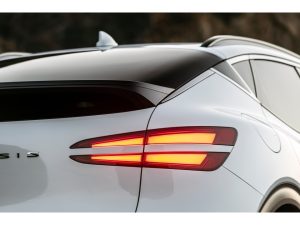
Some buyers might like the idea of driving a vehicle like the electric G80 (or GV70) that looks almost identical to the non-electric version and thus doesn’t call as much attention to its electric drivetrain.
But the GV60 is not a conversion – and though Genesis calls it a crossover, it doesn’t look like most of the rest do. It’s more of an actual crossover – in that it looks more like a car than an SUV (most crossovers are cars that look like SUVs) which makes it different from most of the rest.
Base price is $59,290 for the Advanced trim – which goes the farthest (248 miles) because it’s not the fastest. The $68,290 Performance trim is faster – zero to 60 in just under 4 seconds – but it doesn’t go as far.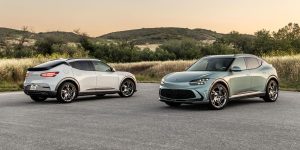
Just 235 miles.
Others in this class include the slightly larger, more SUV-looking Audi A4 e-tron ($49,800 to start) and the slightly smaller, more crossover-looking Volvo C40 Recharge ($55,300 to start) and the Tesla Model Y ($49,990 to start).
What’s New for 2023
The GV60 is a new model, just added to the Genesis lineup.
What’s Good
Fast (0-60 in 4.5 seconds) and faster (0-60 in less than 4 seconds).
Doesn’t look like other crossovers but has the interior space that makes crossovers popular – because they’re more practical.
Standard equipment list is generous.
What’s Not So Good
Expensive relative to rivals in the class like the Audi Q4 e-tron and Tesla Y – which both start for about $10k less.
Range isn’t much, even if you don’t want to go fast.
Standard fingerprint/facial entry system might give some potential buyers the creeps – in part because it’s not optional.
How fast do you want to go?
The GV60 comes standard with 314 horsepower – made by a pair of electric motors (one for the front wheels, the other for the rear wheels) fed electricity by a 77.4 kilowatt-hour battery pack.
This can get you to to 60 in about 4.5 seconds.
If you want to get there faster, the Performance trim offers 429 horsepower (and 516 ft.-lbs. of torque) which can get you to 60 in about 3.8 seconds.
But how much does all this speed cost – in terms of how far you can go?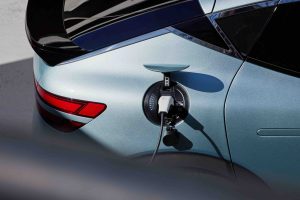
The Advanced version of the GV60 that can get to 60 in 4.5 seconds can go about 248 miles when fully charged; the Performance version’s range dips to 235 miles – which isn’t much of a cost, relative to the speed you get.
However, neither version goes very far – even if you don’t drive them very fast. This is a problem that affects all the EVs in the GV’s class as well as generally. The Audi Q4 e-tron’s standard range is only slighter greater (265 miles) and the Volvo C40 Recharge’s range (226 miles) is slightly lower. The Tesla Y goes farthest – 279 – miles – but that’s still not very far. It’s about half as far as many non-electric small crossovers can go – though to be fair, few of them can get you to 60 in 4 seconds or less.
The reason for the short-leash is a function, in part, of weight – which takes power to move. Which uses up energy to do that.
The GV weighs 4,696 pounds . . . empty. With a driver and one passenger on board, it weighs more than 5,000 pounds, or more than a full-size, non-electric half-ton pick-up truck such as the Ford F-150 – which weighs 4,465 pounds (empty) or 231 pounds less than this compact-sized electric crossover.
But why does the GV (and other EVs) weigh so much?
Because it has to.
Well, it does if you want to be able to drive it as far as it can go. To be able to do that, a very large and very heavy battery pack is needed in order to store the energy needed to keep an EV rolling for more than a very short while. Even with 1,000-plus pounds of battery pack, an EV like the GV only carries the energy equivalent of about 6-7 gallons of gasoline, or about half a tank because that’s all it can store. To go farther, you’d need an even larger – even heavier battery pack.
Which would take more energy to get moving. You perhaps see the problem.
How to compensate potential buyers for this cost? Well, give them speed in exchange. Electric motors are very powerful for their size (and weight). Think of the cordless drill you probably own – and how much twist-action it delivers. Lucky for us, electric drills are light because they don’t have to move.
EVs do – and people understandably expect them to keep moving. That’s why they’re so heavy. And that’s why they don’t go very far, compared with other cars. But they are speedy – because it’s easy to get even 5,000 pounds moving quickly using powerful electric motors. Ironically – and contrarily, relative to speedy non-EVs – it doesn’t burn up a lot of power as such to turn an electric motor. The problem – as regards range – is simply that the EV is so heavy.
If it weren’t for the weight of the battery, an EV such as the GV would be even speedier – just the same as a high-performance non-EV lightened up by removing weight-adding body panels and so on. The problem is you can’t lighten up an EV without it costing more range, which is a problem because EVs haven’t got much to begin with.
So, give ’em speed, instead.
The GV is very speedy – even without paying extra for the Performance version. Being able to get to 60 in just over 4 seconds is as speedy as a gas-engined Mustang GT – and the GV is a crossover, not a two-door high-performance car.
The Performance version of the GV is speedier than a Mustang GT. And both versions of the GV can carry 4-5 people realistically.
But the Mustang can go more than 440 highway miles (and more than 320 city miles) on just 15.5 gallons of gas, in part because the latter only weighs about 100 pounds – and that weight goes down as you drive.
An EV with an “empty” battery weighs as much as one with a fully charged one.
So what you have here is kind of like having a Mustang GT that can only carry around about half a tank of gas. This would not be a problem except for the other problem – that of refilling theEV’s “tank.” A Mustang with half a tank would have to stop twice as often for more gas. But this would only cost you a few minutes, which is all the time it takes to pump 7 gallons of gas into a non-EV’s tank. A small hassle but not a major inconvenience, especially if you forgot to fill up the night before and have to be at work on time in the morning.
With EVs you also have to stop more often. But it’s much more of a hassle if you haven’t got the minimum of 15-30 minutes it takes to “pump” even a partial charge into an EV’s battery pack at a commercial “fast” charger, which may or may not be close by when you need one. It’s also not especially luxurious to have to spend all that time at a “fast” charger, most of them being located at strip mall/big box retail store parking lots. This latter could prove to be a problem for a luxury brand such as Genesis. After all, if you’re paying more, you probably expect not to have to wait in line all the time. It’s part of the reason why people who can afford it buy first class airplane tickets – so they can board first and get off first.
There is a compounding factor to consider.
The GV I test-drove (like every EV I have test driven) had a real-world-driving range that was about 10-20 percent less than advertised. The lower figure while driving it not speedily – so as to conserve energy. You have control over that. You do not have control over where you drive or driving conditions. The range advertised by EVs assumes mostly flat driving and temperate weather. If you drive up hills – in the cold – the range will decline quickly, even if you’re not driving speedily. See that part about lugging around 5,000 pounds. Compounded by doing it uphill. And by cold weather, which do to electric batteries what salt does to slugs. Especially if it’s really cold – and you want to keep warm.
So, I had about 200 miles of real-world range to work with. For me, this is sufficient for two days’ driving – without charging. One can keep things going by remembering to plug in as soon as you come home – and then stay home until tomorrow, understanding it takes overnight to fully charge an EV battery at home, using Level II (240V) charging.
But if you forgot . . .
And what if you want to go somewhere else, after you got home?
For people who don’t need to be able to drive farther than 50 or so miles in a day, it’s less of a problem, especially if you remember to plug in when you get home. But one wonders whether most people will willingly accept cars that only go about half as far as other cars and that require constant thinking about where, when – and how long – it will take to charge them.
No matter how speedy they are.
One of the criticisms leveled at crossovers – electric and not – is that they all look the same.
Most do.
This one doesn’t.
It’s a departure from the usual box-on-top-of-a-box melted for 90 seconds in the microwave look that has made most crossovers look like most other crossovers. The GV is wasp-waisted and fast-backed, with a sporty car’s windshield rake and A pillar taper. It also doesn’t look particularly electric because Genesis didn’t ape Tesla and do a Neo (in The Matrix) interrogation-scene elimination of the mouth look. Even though the GV does not need airflow over the radiator that’s not there, it still has what looks like a grille up front – as opposed to a swath of body-colored plastic, a la Tesla (and a la Volvo, too).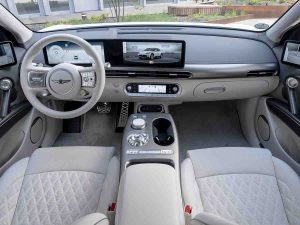
It’s not an over-the-top gaping bullfrog mouth, either.
Inside, there’s what looks like a single, integrated LCD display panel that stretches from in front of the driver almost to the front seat passenger’s side. It is actually two separate displays, one the main instrument cluster in front of the driver, the one to his right the screen that displays controls for secondary functions. It’s a much richer look than the bleak single huge (and centrally mounted) LCD touchscreen one sees inside Teslas.
There are rotary knob controllers on the center console, to put the GV into Drive or Reverse and to select the Drive Mode (tailored for performance or range, etc.)
Despite not looking like most crossovers, the GV has the room inside that makes crossovers popular: 24 cubic feet behind the second row (about twice the available space inside the trunks of most small sedans) and 54.7 cubic feet if you fold those down. The space available in the Audi A4 eTron is almost identical (24.8 cubic feet behind the second row and 53.1 cubic feet when they’re folded) and significantly more than in the Volvo C40, which only has 14.6 cubic feet of space behind its second row (49 cubic feet with them folded). The Tesla Y bests them all, though – with 34.3 cubic feet of room behind its second row and 76.2 with the second row folded).
The wide-opening rear liftgate makes the most of the available space, too.
Being a Genesis – which is to say, being a luxury-brand (and priced) vehicle – the GV comes standard with just about everything – except the optional speed. This includes heated leather seats (and steering wheel), 20 inch wheels, a Heads Up Display (HUD) and a very good 17 speaker Bang & Olufsen premium audio system.
In addition to more speed, the Performance version gets premium quilted leather seats, heated rear seats, 21 inch wheels and some additional performance upgrades, such as higher-capacity brakes.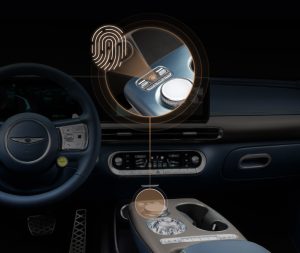
The Rest
Some cars offer keyless entry. The GV offers fingerprint – and face recognition – entry. And drive.
This is a first for Genesis and probably for most people, too. Whether you want to be fingerprinted and face-scanned by your car is something else. For good – or not – this technology is standard equipment in this EV.
The Bottom Line
Speed is no longer just a question of money.
How far do you want to be able to go?
. . .
If you like what you’ve found here please consider supporting EPautos.
We depend on you to keep the wheels turning!
Our donate button is here.
If you prefer not to use PayPal, our mailing address is:
EPautos
721 Hummingbird Lane SE
Copper Hill, VA 24079
PS: Get an EPautos magnet or sticker or coaster in return for a $20 or more one-time donation or a $10 or more monthly recurring donation. (Please be sure to tell us you want a magnet or sticker or coaster – and also, provide an address, so we know where to mail the thing!)
My eBook about car buying (new and used) is also available for your favorite price – free! Click here. If that fails, email me at [email protected] and I will send you a copy directly!






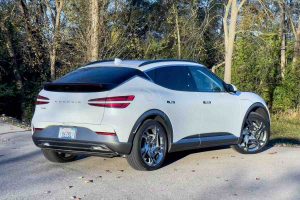








It just makes me sick all the cars and trucks that could have been developed instead of these devices…..
Genesis has a uphill battle to be seen as a luxury car maker, but electric makes that job even harder.
Still no word on the GV-70 that I “ordered” back in late February. I use the scare quotes because it is a non-binding agreement, i.e., you tell ’em the build-out and “in 3-6 months” they will deliver it. You pay a $100 fee for the privilege.
The reason that I went with GV-70 is specifically because I could not find a wagon that I would drive in my price range (new) and because the GV-70 is very “wagon-like” (IMO) in terms of styling. I absolutely hate the “box on wheels” that so many people seem to be fond of these days. That’s what I love about the GLE (4-door) “coupe” aka “the turtle” — however out of reach for me as well (at least new).
Along those lines, I am not a fan of the GV-80. It is more of the “box on wheels”.
The GV-70 has the cargo requirement that I have, i.e., comfortably carry my wife and dog and all of our respective shit for a 5-day out-of-town visit that is 5 hours away (or more).
Even if the GV-60 was not electric, I think it would be too small for me. But the EV thing makes it unacceptable for me. Genesis is going to electrify the GV-70, pretty sure. There’s NFW that I would buy one of those.
I went to Asheville over the weekend. About 7.5 hour drive from my house and at one point I noticed the elevation was way up around 2800ft or so. And very long segments of nearly nothing along the way. Making that trip in an EV would be so burdensome that there’s no way, I would do it. It would become a 10+ hour trip even if I left home fully charged. Forget it!
Another use case where the EV version wouldn’t work for me is towing. I plan on taking my GV-70 3.5T out to the Floyd, VA area where I have spotted some wonderful locally and hand-made outdoor furniture that I plan on towing home — ~240 miles with lots of hills. During the summer, I’d have the AC running the entire time. And I don’t drive like a milquetoast zombie.
Lastly, I’m getting the “Sport Advanced” package on the GV-70. There is a lower and a higher trim level. It sounds like they threw in the “Sport Prestige” equipment (on the GV-70) onto the GV-60 for better selling potential. For example, despite GV-70 3.5T being “up the food chain” from GV-60, I won’t be getting Bang & Olufsen (or whatever stereo), nor heated seats in the back, nor 3-way climate control, nor heads up display, etc, etc.
I’ve noticed that “carrot and stick” becoming fairly common now.
Beyond the creepiness of the finger print reader and face scanner is how hard will it be to find repair parts for these rolling wonderwagons as they age? Only time will tell.
I cannot see any reason to accept the intrusive fingerprint and/or facial recognition. The slope is getting steeper and slippery darn quickly
Right, plus I guarantee that data is sent straight to the FBI.
I agree, Greg –
They’re doing this to habituate people to and normalize “biometric” cattle-tagging. This ought to be another hard NO. If not, it will spread – via the idiocy of those who are addled by “convenience.”